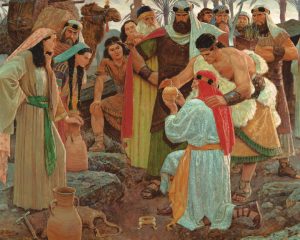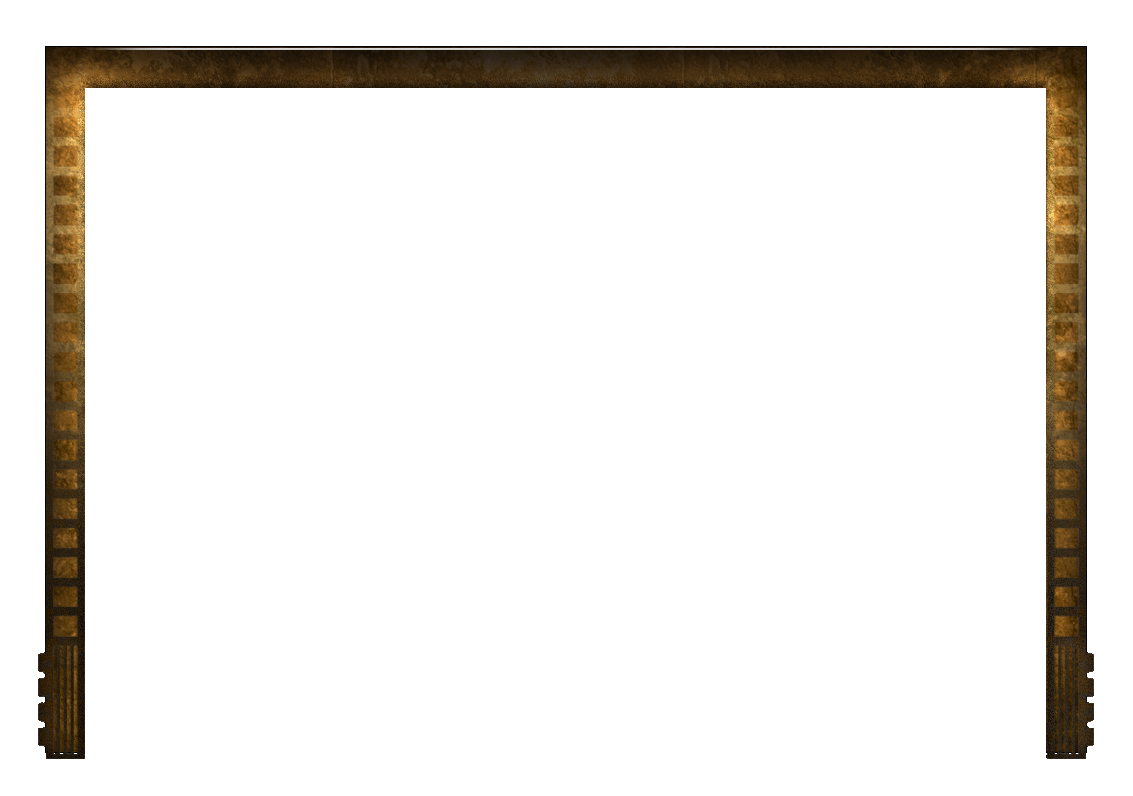From Jerusalem to Bountiful
The first DVD in the Journey of Faith series plots the journey started in 600 BC by the Israelite Prophet Lehi and his family as they made their exodus from Jerusalem across the Arabian desert to the coast. The second DVD discusses the religious milieu, culture, the land, and language surrounding the descendants of Lehi and Sariah in the New World. Lehi’s son, Nephi, begins the scriptural account in 600 BC, preserving it by engraving on metal plates. The narrative did not come to light until the 1820s, when by divine revelation, Joseph Smith was directed to the plates and unearthed them from a hill in upstate New York. From them he translated the Book of Mormon: Another Testament of Jesus Christ.
 The Book of Mormon contains accounts by several different people over a thousand years, harmonized and abridged into a whole narrative by a father and son, Mormon and Moroni, who lived around 400 ad., including an account of the visit of Jesus Christ to the Nephite people in the Americas after His resurrection.
The Book of Mormon contains accounts by several different people over a thousand years, harmonized and abridged into a whole narrative by a father and son, Mormon and Moroni, who lived around 400 ad., including an account of the visit of Jesus Christ to the Nephite people in the Americas after His resurrection.
This first article on external evidences focuses on what has been determined about Lehi’s journey from Jerusalem to the point on the southern coast of Oman from where he and his family sailed to the New World.[1]
In 1976, Lynn and Hope Hilton traveled to Saudi Arabia and southern Oman to try to establish the point from which Lehi and his family sailed to the Americas.[2] Following on from that initial trip, several forays have been made not only to discover the Book of Mormon’s “Bountiful,” (see 1 Nephi 17:5), but also the route which Lehi and his family took from Jerusalem.
S. Kent Brown has done extensive research, both on his own and with a team of experts from several universities into the ancient trade route known as the Incense Trail—the likely route from Jerusalem. These findings have been a regular feature of the Journal of the Book of Mormon and Other Restoration Scripture.[3]
Jerusalem
Much work has also been done to anchor the Book of Mormon account to what is known of 600 BC Jerusalem. In 2004, the Maxwell Institute published Glimpses of Lehi’s Jerusalem, edited by John W. Welch, David R. Seely, and JoAnn H. Seely.
This book tries to answer such questions and to glimpse parts of that world. Much of that era was lost forever, of course, when the warnings of many prophets came to pass as Jerusalem was destroyed by the Babylonians shortly after Lehi left Jerusalem. The Temple of Solomon and the walls of the city were torn down. Buildings were burned. Treasuries were looted. People were killed or deported. Many records were destroyed, and certain religious beliefs were changed or extinguished. Most of what we know about these events comes from accounts written by a few of the survivors and influenced by their biases. Archaeological and textual evidence allows us to snatch only a glimpse of this and a peek at that. Carefully linked together, however, these snapshots blend into a helpful and interesting vista.[4]
Valley of Lemuel
The first landmark in the account of journey of the family of Lehi into the wilderness beyond Judaea is the “Valley of Lemuel,” so-named by Lehi:
“And he [Lehi] came down by the borders near the shore of the Red Sea and he traveled in the wilderness in the borders which are nearer the Red Sea; . . . And it came to pass that when he had traveled three days in the wilderness, he pitched his tent in a valley by the side of a river of water. . . . And he also spake unto Lemuel: O that thou mightest be like unto this valley ( 1 Nephi 2:5–10). Thereafter it was referred to as the “Valley of Lemuel” (see 1 Nephi 2:14; 9:1; 10:16: 16:6). S. Kent Brown, in summarizing the attempts to discover the location of this valley, determines that Wadi Tayyib al-Ism in northwest Arabia is a very likely candidate:
The canyon, called Wadi Tayyib al-Ism, appears to fit snugly with Nephi’s description of a “valley, firm and steadfast, and immovable” featuring a “river, continually running” (1 Nephi 2:9–10). This find is set into profile all the more because surveys have concluded that “the Red Sea . . . is left without a single flowing river. In this respect the Red Sea is unique.” Only on the coast of Yemen does one find year-round streams such as Wadi Hagr that drain to the south, but not into the Red Sea.
It may seem that the fact that it does not currently drain into the Red Sea would rule it out, but, as Brown continues to explain that with the passage of time the land has risen so that, “clear geological evidence exists that the northwest coastline of Arabia has been rising. . . . all geological indicators point to the current mouth of Wadi Tayyib al-Ism lying under the waters of the Red Sea in antiquity.” [5]
Nahom
When Lehi and his family, now augmented by the family of Ishmael, whose children married those of the family of Lehi (see 1 Nephi 16:7), were well into their desert journey, Ishmael died: “And it came to pass that Ishmael died, and was buried in the place which was called Nahom (1 Nephi 16:34). Again, Kent Brown summarizes for us the significance of this seemingly insignificant mention,
Hugh Nibley and others since him have observed that the passive phrasing, “the place that was called Nahom” (emphasis added), connotes that the name had already been conferred on that area by local inhabitants before Lehi’s clan arrived. Unlike the case of “the Valley of Lemuel,” father Lehi did not coin his own name for this spot. Other people were already there and the little party had to cope with their presence.
In a “Baran temple in Marib, the ancient capital of the Sabaean kingdom that lies about 70 miles due east of modern Sana’a, the capital of Yemen,” an ancient altar was unearthed that bears the inscription, “a certain Biathar . . . a Nihmite,” donated the altar to the temple. [6] This appearance of the root letters *NHM (ancient Semitic languages had no vowels), is strong indication of the existence of the ancient place called Nehem in the Book of Mormon.
Bountiful
If no small effort has been expended to locate the Valley of Lemuel and the burial place of Ishmael, it nevertheless pales in comparison to the extent of the archaeological forays into establishing where Nephi built his boat and where the party sailed for the New World, “And we did sojourn for the space of many years, yea, even eight years in the wilderness. And we did come to the land which we called Bountiful, because of its much fruit and also wild honey” (1 Nephi 17:4–5).[7] The consensus is that somewhere along the southern coast of Oman (an area at times rich in natural harbors and vegetation), conditions were such that Lehi’s son Nephi would have been able to find the material necessary to build a boat. In addition, the families would have been able to live there, finding adequate food and water, for the amount of time such a huge undertaking would need.
[1] The Neal A. Maxwell Institute for Religious Scholarship has published several books that throw light on the ancient origins of the Book of Mormon. For instance, Daniel C. Peterson, Donald W. Parry, and John W. Welch, eds., Echoes and Evidences of the Book of Mormon (Provo, UT: FARMS, 2002). The Institute’s flagship publication, now titled Journal of Book of Mormon and Other Restoration Scripture, has published many articles dealing with internal and external evidences over the years. There is a companion book to the first Journal of FaithDVD: Journey of Faith: From Jerusalem to the Promised Land.
[2] See Lynn and Hope Hilton, In Search of Lehi’s Trail (Salt Lake City: Deseret Book, 1976). The reader is encouraged to open the PDF versions of the articles referenced here to see the rich photography and illustrations that accompany them.
[3] See, for instance, the discussion, “Planning the Research on Oman: The End of Lehi’s Trail,”; “The Hunt for the Valley of Lemuel,”; “New Light: Nahom and the ‘Eastward’ Turn,”. See also, “The Golden Road,” in the Journey of Faith companion book.
[4] “Introduction,”.
[5] S. Kent Brown, “Hunt for the Valley of Lemuel.”
[6] S. Kent Brown, “‘The Place That Was Called Nahom’: New Light from Ancient Yemen,”. A search on the Maxwell Institute site for “Nehem” will give the reader several more articles that confirm this evidence.
[7] See, for instance, Warren P. Aston, “The Arabian Bountiful Discovered? Evidence for Nephi’s Bountiful,”; Richard Wellington and George Potter, “Lehi’s Trail: From the Valley of Lemuel to Nephi’s Harbor,”; Wm. Revell Phillips, “Mughsayl: Another Candidate for Land Bountiful,”.

